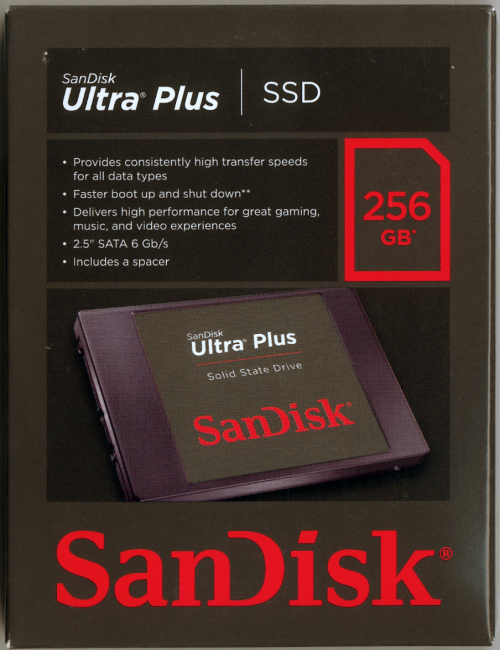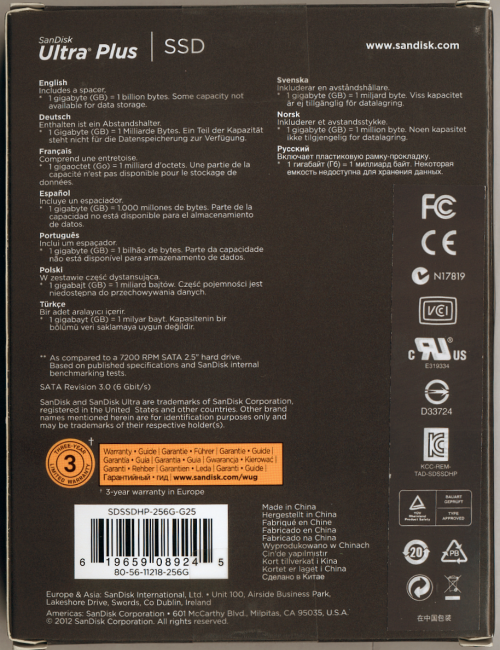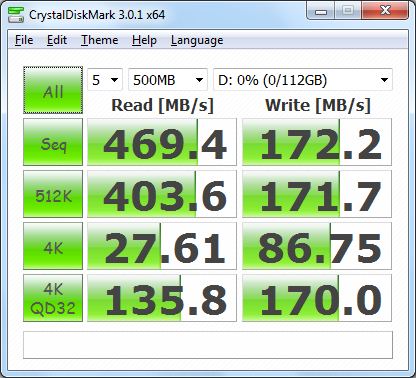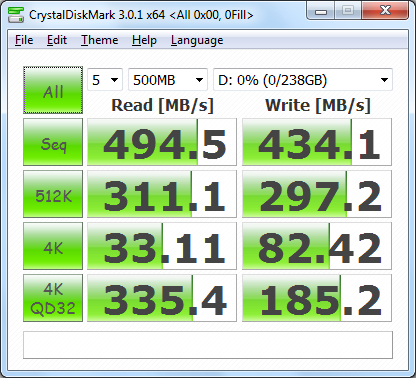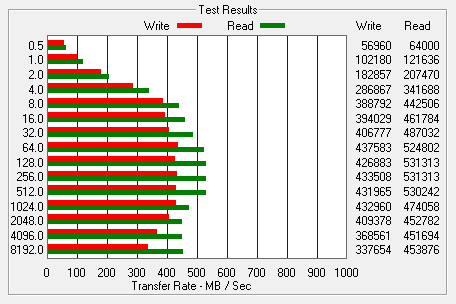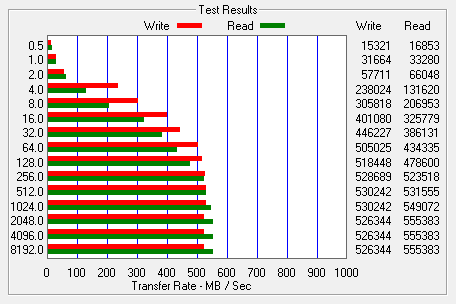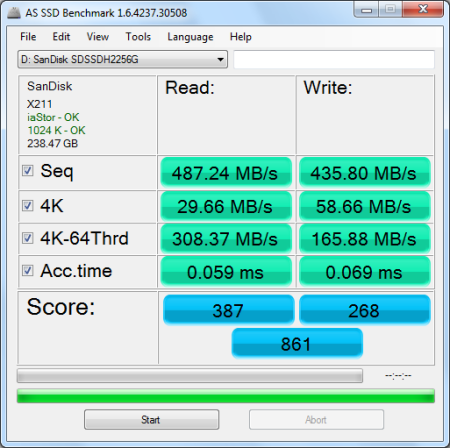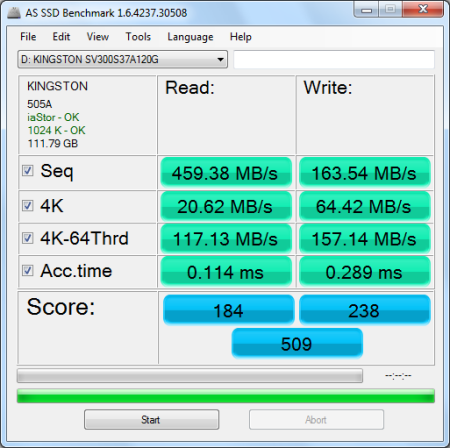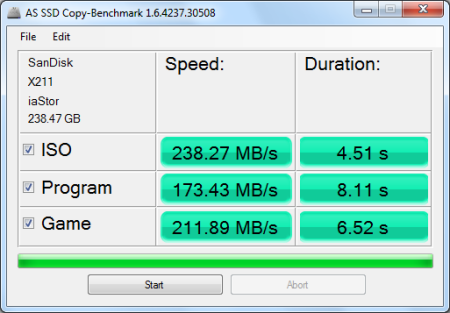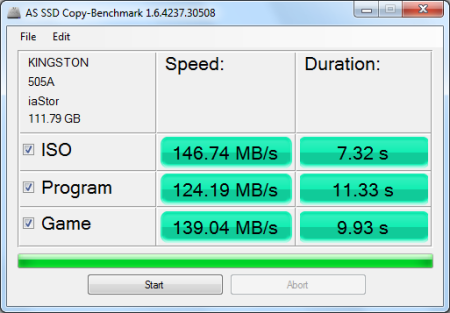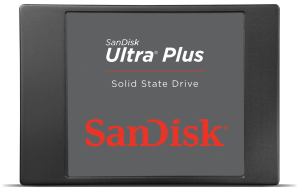

Model: SanDisk Ultra Plus 256GB Solid State Drive
Manufacturer: SanDisk
Provided By: SanDisk
SanDisk has been a leader in the storage industry for more than 20 years. Founded in 1988 by Dr. Eli Harari, the company has grown from a three-person Silicon Valley startup to the world's largest provider of flash memory storage solutions. The company offers a wide range of products including memory cards, USB flash drives, SSDs and its popular line of Sansa music and video players.
Over the last year or so, SanDisk has introduced a number of new solid state drives for the consumer market. The latest addition to their product lineup is the Ultra Plus. This new consumer-oriented SSD is powered by Marvell's 88SS9175 controller chip and is equipped with SanDisk's own 19nm eX2 ABL MLC NAND to deliver up to 530MB/s read and 450MB/s write speeds. The Ultra Plus also packs 128MB of DRAM cache and offers features like TRIM support, dynamic wear-leveling, background garbage collection and SanDisk's nCache technology which uses a large non-volatile SLC cache to improve random write performance. The nCache accumulates small writes at high speed and then flushes them to the larger MLC section of the NAND flash memory array.
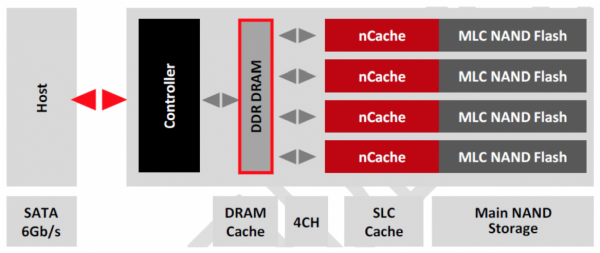
The Ultra Plus is available in 64GB, 128GB and 256GB capacities. For this review, SanDisk sent us the 256GB version of the drive which is capable of delivering up to 530 MB/s sequential read and 445 MB/s sequential write speeds as well as up to 82,000 random read and 39,000 random write IOPS.
| SanDisk Ultra Plus 256GB Solid State Drive | |||||||||||||||||||||||||||||||||||||||||||||||
General Specifications
Performance
Reliability
Power Consumption
Environmental
Dimensions and Weight
Other Features
|
Needless to say, this is only a taste of what the Ultra Plus has to offer. To give you an idea of what to expect, we'll take a closer look at SanDisk's new SSD and then see how well it performs. Does the Ultra Plus have what it takes? Can it deliver the value and performance we've come to expect from SanDisk? Keep reading as we find out.
The Ultra Plus comes in a small, red and white box. While there aren't a lot of details on the back, the front advertises the drive's 256GB capacity as well as the performance benefits it has to offer. Inside the box, you'll find the Ultra Plus, a 2mm spacer for notebook installations and an installation guide.

Physical Features:
The Ultra Plus looks very similar to SanDisk's other 2.5" SSDs. The top of the outer casing is made out of black plastic with a large, gray and red sticker showing that the SSD is part of the company's Ultra Plus series. The bottom of the casing is made out of metal and is painted black to match the top. The large sticker on the bottom covers the screws holding the drive together and shows information like the part number, capacity and serial number.


Upon opening the case, I was a bit surprised to see how small the Ultra Plus' PCB was. Instead of using a regular size PCB, SanDisk has placed a half-slim SATA SSD inside of a 2.5" case.
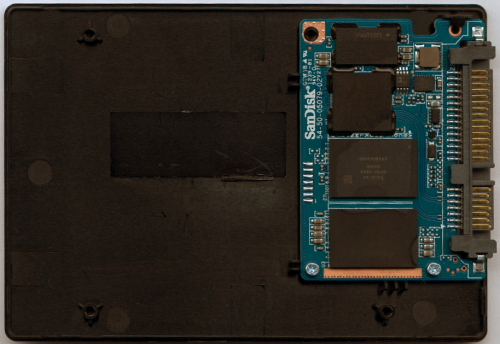
As I mentioned earlier, the Ultra Plus uses Marvell's 88SS9175 controller chip. The 88SS9175 is very similar to the 88SS9174 "Van Gogh" controller found in the Corsair Performance Pro, Intel SSD 510 and Plextor's M2 and M3 series SSDs. However, instead of eight channels, the 88SS9175 has only four.
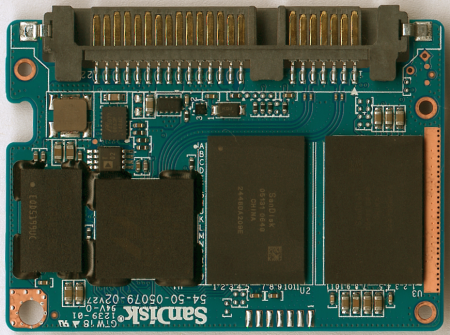

For the Ultra Plus, SanDisk opted to use their own 64GB 19nm eX2 ABL MLC NAND flash chips. Looking at the picture above, you can see that there are two of these chips on either side of the PCB. The drive also has a 128MB Samsung DDR2 DRAM memory chip that is used for caching.
The test system used in this review was an HP 8200 Elite. The computer came equipped with an Intel Core i5-2400 CPU, 4GB of DDR3 1333MHz memory, Seagate Barracuda 7200.12 ST3250312AS 250GB SATA 6 Gb/s hard drive, NVIDIA Quadro FX580 512MB PCIe graphics card and an Intel 82579-LM gigabit network card. For the operating system, I installed a fresh copy of Windows 7 Enterprise.
To test the performance of the SanDisk Ultra Plus SSD, I ran a series of benchmarks using CrystalDiskMark 3.0.1, HD Tach RW 3.0.4.0, ATTO Disk Benchmark 2.46, AS SSD, HD Tune Pro 4.61, Anvil's Storage Utilities and Iometer. For comparison, I've also included test results from the Samsung SSD 840 Pro, Kingston SDNow V300, Silicon Power S70, Plextor PX-256M5P, OCZ Vertex 4, Kingston HyperX 3K, and SanDisk Extreme.

As I mentioned earlier, the Ultra Plus is based on Marvell's 88SS9175 controller chip. Looking at the screenshot above, you can see that it performs equally well with both incompressible (0%) and compressible (100%) data.
CrystalDiskMark 3.0.1:
First, I ran a few quick tests using CrystalDiskMark. This benchmark tool measures the performance of a storage device by testing its sequential read and write speeds as well as its random read and write speeds using blocks 512K and 4K in size.
According to SanDisk, the 256GB Ultra Plus is capable of reading at 530 MB/s and writing at 445 MB/s when connected to a SATA 6 Gb/s port. While the drive performed well, it came up a bit short of these numbers in CrystalDiskMark's sequential read and write speed tests.
The Ultra Plus performed equally well when using highly compressible 0x00 (0 Fill) data. This time around, the drive was able to read at 494.5 MB/s and write at 434.1 MB/s.
HD Tach RW 3.0.4.0:
Next, I used HD Tach to test the Ultra Plus' read, write and burst speeds as well as its seek times and CPU usage.
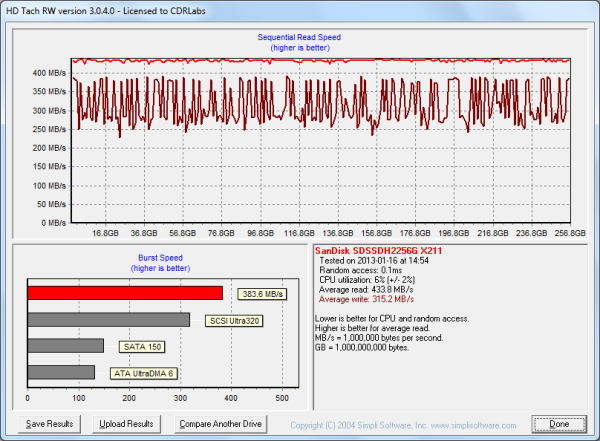
Looking at the screenshot above, you can see that the Ultra Plus had average read and write speeds of 433.8 MB/s and 315.2 MB/s respectively, as well as a burst speed of 383.6 MB/s.
ATTO Disk Benchmark 2.46:
I also used ATTO Disk Benchmark to test the Ultra Plus' sequential read and write speeds. The tests are run using blocks ranging in size from 0.5KB to 8192KB and the total length set to 256MB.
When tested with ATTO, the Ultra Plus' read speeds topped out at about 531 MB/s and its write speeds at 433 MB/s.
AS SSD:
AS SSD is a relatively new benchmark designed specifically for solid state drives. The application contains five synthetic tests used to determine the sequential and random read and write performance of a drive.
AS SSD also includes a copy benchmark. This test copies an ISO (two large files), program (many small files) and game (small and large files), returning the speed and duration of each.
HD Tune Pro 4.61:
Next, I ran a series of tests using HD Tune Pro. This hard disk utility measures a drive's performance by testing its sequential read and write speeds as well as its access time, burst rate and CPU usage. For this review, I'm also going to use it to benchmark the Ultra Plus' random read and write speeds, random access times and the number of operations per second.
 SanDisk Ultra Plus SSD 256GB - HD Tune Read Benchmark |
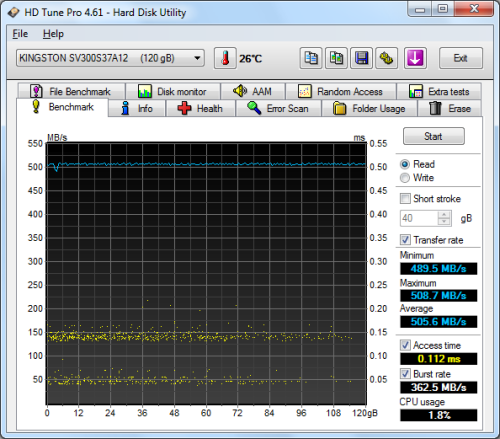 Kingston SSDNow V300 120GB - HD Tune Read Benchmark |
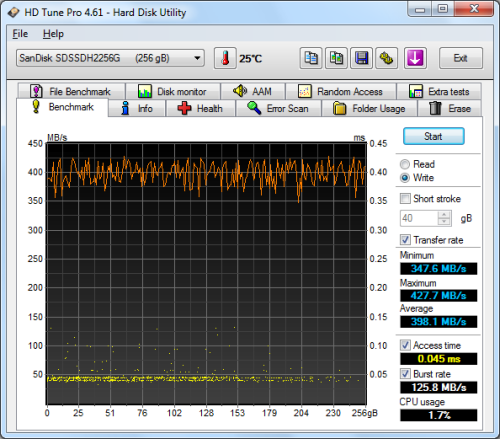 SanDisk Ultra Plus SSD 256GB - HD Tune Write Benchmark |
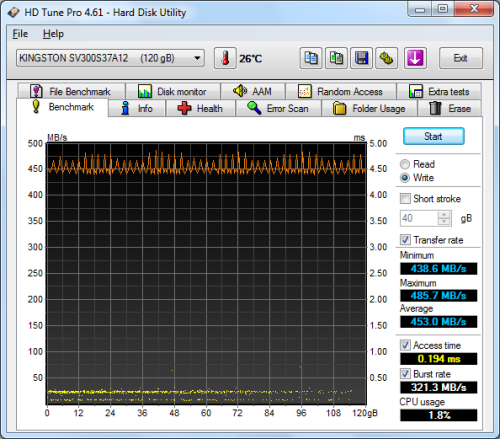 Kingston SSDNow V300 120GB - HD Tune Write Benchmark |
The Ultra Plus performed very well when benchmarked with HD Tune. The drive had average read and write speeds of 510.4 MB/s and 398.1 MB/s, respectively, as well as a burst rate of 124.7 MB/s when reading.
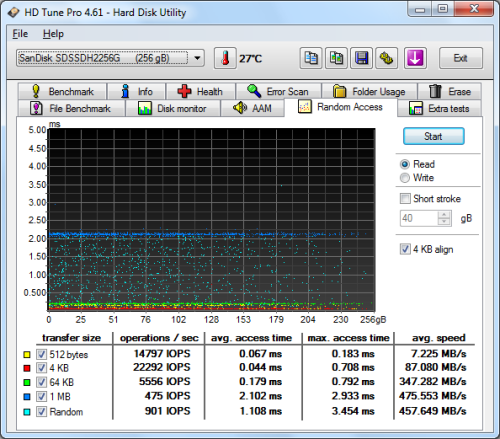 SanDisk Ultra Plus SSD 256GB - HD Tune Random Access Read |
 Kingston SSDNow V300 120GB - HD Tune Random Access Rea |
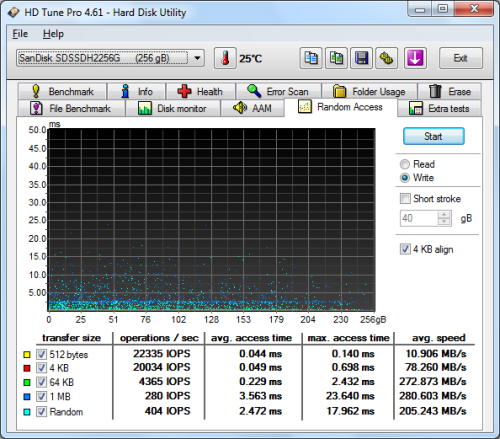 SanDisk Ultra Plus SSD 256GB - HD Tune Random Access Write |
 Kingston SSDNow V300 120GB - HD Tune Random Access Write |
The Ultra Plus didn't disappoint when doing random reads and writes. When writing 4KB blocks, the drive reached 20,034 IOPS and had an average speed of 78.260 MB/s. The Ultra Plus was even faster when reading, reaching 22,292 IOPS with an average speed of 87.080 MB/s.
Anvil's Storage Utilities:
Anvil's Storage Utilities is another new benchmark designed with SSDs in mind. The standard storage benchmark measures a drive's performance by testing its transfer speeds, access times and IOPS.
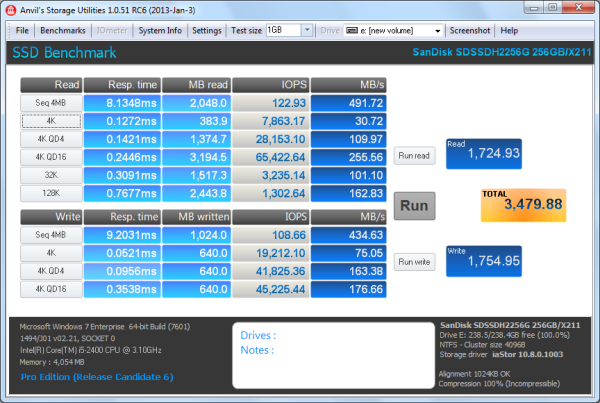
Iometer:
Lastly, I ran a series of tests using Iometer. This tool can be configured to benchmark a number of things. In this case, I used it to measure the Ultra Plus' read and write speeds and the number of operations per second. The tests were run using random bytes and a queue depth of 3.
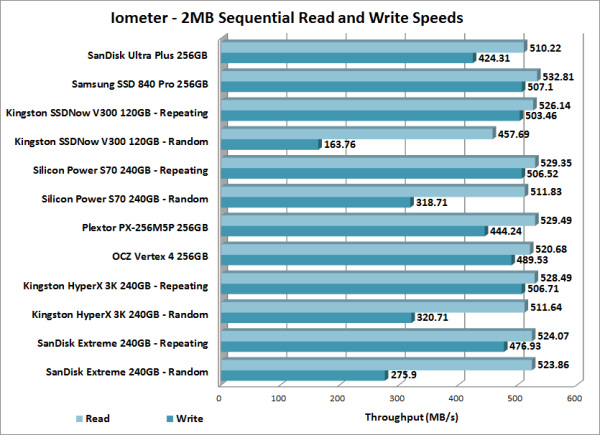
The Ultra Plus' performance was very similar to what we saw in our other tests. The drive was able to read at 510.22 MB/s and write at 424.31 MB/s.
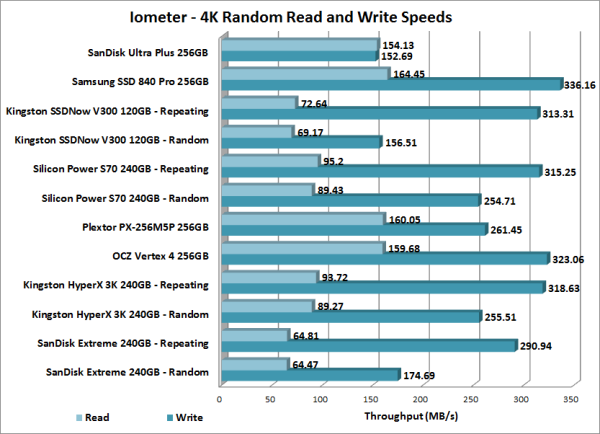
The Ultra Plus' random read and write performance was hit and miss. While the drive was able to read at a respectable 154.13 MB/s, its random write speed topped out at only 152.69 MB/s.
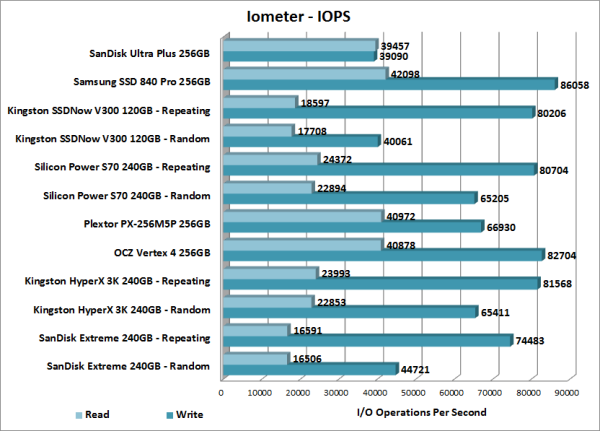
According to Sandisk, the Ultra Plus is capable of 82,000 IOPS when reading and 39,000 IOPS when writing 4K blocks. In our tests, the drive reached 39,457 random read IOPS and 39,039 random write IOPS. Increasing the queue depth had little impact on the Ultra Plus' random write performance. However, with the queue depth set to 32, the drive was able to reach 81,577 random read IOPS.
TRIM Performance:
While SSDs offer many benefits, there are some downsides to using flash memory. One of the biggest issues people run into is performance degradation. Over time, an SSD will run out of fresh blocks and will have to write over data the file system has marked as deleted. This procedure is very complicated and can slow an SSD's write speeds considerably.
To address this problem, most manufacturers have added TRIM support to their SSDs. The TRIM command allows an operating system, such as Windows 7, to tell an SSD which data blocks are no longer in use. Using this information, the drive pro-actively erases these blocks and adds them to the free block pool.

To test the Ultra Plus' TRIM function, I first put the drive in a "dirty" state. I used Iometer to fill the entire drive and then ran a random write test for 30 minutes. This had very little effect on the Ultra Plus' read speed. However, its average write speed dropped to a mere 30.3 MB/s.

SanDisk Ultra Plus SSD - Dirty
To see how well the Ultra Plus could recover, I let the computer sit for a few hours and then reran the test. The drive wasn't able to reach the factory fresh performance shown in our earlier tests. However, its average write speed climbed up to 180.7 MB/s.
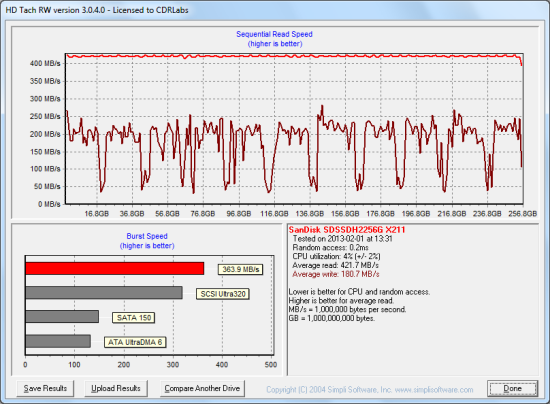
SanDisk Ultra Plus SSD - After Trim
Lastly, I used Parted Magic to perform a secure erase on the Ultra Plus. With the drive wiped clean, its write speed jumped back up to 321.8 MB/s.
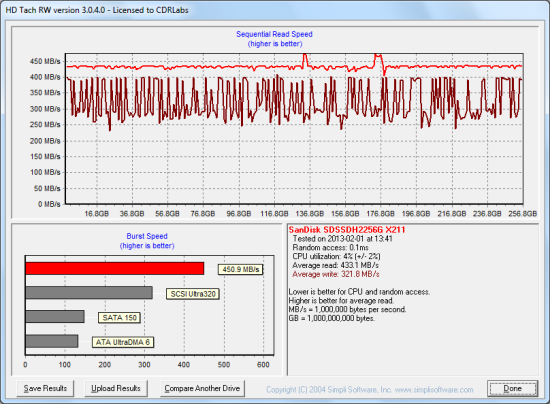
SanDisk Ultra Plus SSD - Secure Erase
Final Thoughts:
The SanDisk Ultra Plus SSD is a welcome change from the myriad of "SandForce Driven" SSDs on the market today. This ultra-slim drive combines Marvell's 88SS9175 controller with SanDisk's own 19nm eX2 ABL MLC NAND flash to deliver a fast, responsive computing experience at an affordable price. In our sequential read and write tests, the Ultra Plus was able to read at speeds as high as 531 MB/s and write at speeds in excess of 430 MB/s. It also performed very well when doing random reads, but lagged behind the other drives in our random write tests, producing only 39,000 IOPS. This may be a deal breaker for some, but the Ultra Plus is still a huge improvement over traditional hard drives and a worthy upgrade for older notebook and desktop computers.
The SanDisk Ultra Plus SSD is available now in 64GB, 128GB and 256GB capacities. The 128GB drive currently retails for about $103 with the 256GB version reviewed here going for less than $170 on Amazon.

Highs:
- Available in 64GB, 128GB and 256GB capacities
- Marvell 88SS9175 controller
- Features nCache Technology
- Good sequential read and write speeds
- Performs equally well with compressible and incompressible data
- SATA 6Gb/s interface
- 128MB DRAM Cache
- Supports TRIM, garbage collection and wear leveling
- Ultra-slim form factor
- Reasonably priced
- 3 year warranty
Lows:
- Mediocre random write performance
